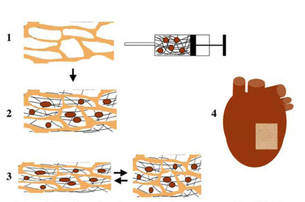Artificial scaffolds
The RECATABI concept.
The myocardial infarct can produce severe ischemic myocardiopathy, leading to a severe afectation in the necrotic tissue function. One of the treatment options that is currently under development is cellular myocardioplastia, in which stem cells are encapsullated in natural or artificial matrixes and applied to the infarcted ventricle. Despite some benefits have been observed with this technique, cell survival is extraordinary low. That is why new therapeutic approaches are needed.
The main objective of the RECATABI project is the development of a bioengenieering platform with progenitor cells that have been previously trainned biomechanically and biophysically to resist their integration in a highly stressed tissue as the heart. These cells will be implanted in a novel design bioactive implant of a microporose membrane loaded with angiogenic factors to improve their survival and cardiogenic differentiation. In adition, the bioimplant is expected to prompt a fast revascularization to assure a regeneration towards a new functional myocardium.
This project is developed in a European consortium named RECATABI (Regeneration of Cardiac Tissue Assisted by Bioactive Implants) and we work toguether with other European research centers.
The obtained results in mice have been very interesting so far: implanted cells live along time and differencaite to cardiomyocites and a significative revascularization is observed between the myocardium and the implant.

Elastomeric membrane loaded with peptide hydrogel and cells to be implanted on an infarcted heart.